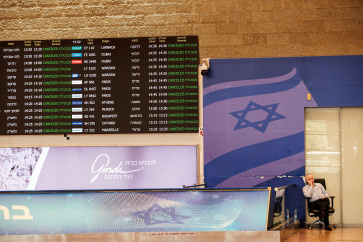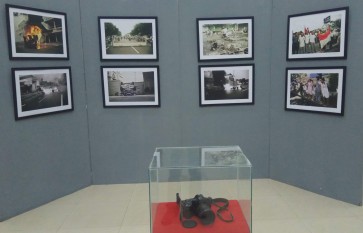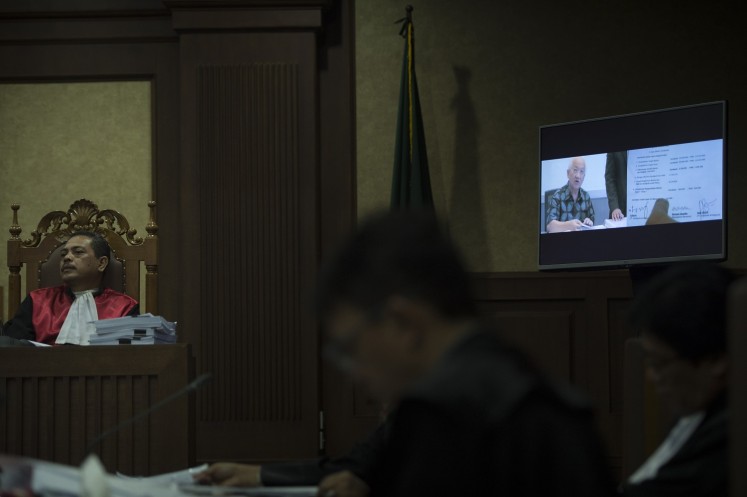Popular Reads
Top Results
Can't find what you're looking for?
View all search resultsPopular Reads
Top Results
Can't find what you're looking for?
View all search resultsBali 1928 - Reviving the legacy
(Courtesy of Jaap Kunst Archives, University of Amsterdam)The last piece: An original 78 rpm record from the historical recordings of 1928-1929 with information on the label printed in Balinese script
Change text size
Gift Premium Articles
to Anyone

(Courtesy of Jaap Kunst Archives, University of Amsterdam)
The last piece: An original 78 rpm record from the historical recordings of 1928-1929 with information on the label printed in Balinese script. This particular record contains “Pubupuh Adri” and is the only existing disc in the world.
It is a story nearly 90 years in the making that has taught a large number of people, from prominent scholars to village musicians, how a past legacy can invigorate present tradition.
The story began in mid-1928, when representatives from German recording company Odeon and Beka traveled across Bali to record the traditional music and songs of the island, which by that time had become known in Europe as a bewitching tropical paradise in the East.
It was a crucial time in the island’s musical history. Bali was in the midst of an artistic revolution with kebyar becoming the new dominant style of music. Gamelan orchestra groups had their older ceremonial instruments melted down and reforged in the new style. Intense competition between villages and regions stimulated young composers to develop impressive innovations and techniques.

Preserved: The Janger dancers of Kedaton, a hamlet in Denpasar. The photograph was taken by Walter Spies, an artist who played a prominent role in popularizing Bali in the West.
The recordings were made under the guidance of Walter Spies, a German painter and long-time resident of Bali. Spies possessed an intimate knowledge of the island and knew most, if not all, of Bali’s top artists and musicians at the time.
In 1929, the diverse sampling of new and older Balinese styles appeared on 78 rpm records with subsequent releases for international distribution. Although the medium limited tracks to three-minute excerpts, the records contained remarkable examples of a broad range of musical genres — vocal as well as instrumental — and outstanding composers, performers and ensembles of the period who are now famous teachers of legendary groups — I Wayan Lotring, I Nyoman Kaler and the gamelan gong of Pangkung, Belaluan and Busungbiu.
It was the first and only commercially released recording of music made in Bali prior to World War II. Unfortunately, it was not a commercial success and quickly went out of production.
The late Andrew Toth, noted ethnomusicologist and a leading expert on Balinese art, wrote that a third of the Odeon and Beka recordings appeared in Europe and America, though the majority had been intended for local sale in Bali. For this reason, the information on the labels was printed in Malay, the lingua franca of the archipelago at the time, and in some cases in Balinese.
The ambitious plan to develop an indigenous market was a complete failure, however, as few Balinese were interested in the new and expensive technology — especially when there was a world of live performances happening daily in temples and households across the island.
“McPhee was the only customer to purchase these 78 rpm discs in an entire year from one frustrated dealer; his collection contains most of the copies that are still preserved to this day, for the agent later smashed the remaining stock in a fit of rage,” he wrote, referring to Colin McPhee, a Canadian musicologist known as the first Western composer to make an ethnomusicological study of Bali.

Every beat: Musicians from Kapal village in Badung regency play gangsa metallophone.
The present generation of Balinese artists would not have had the opportunity to listen to the magnificent music contained on the records if not for the hard work and perseverance of an American scholar.
Edward Herbst first visited Bali in 1972 to study wayang (puppets) and gamelan palegongan under I Made Gerindem in Teges Kanginan, gong-making techniques at Tihingan and Balinese classical dance drama from the legendary I Nyoman Kakul of Batuan.
Later, Herbst had the privilege of studying under other great Balinese masters, including mask performer I Made Pasek Tempo of Tampaksiring, arja vocalist Ni Nyoman Candri of Singapadu and composer I Ketut Rinda of Blahbatuh.
He was a passionate student and meticulous researcher, two qualities that enabled him to overcome numerous obstacles in his next task: searching for the “missing” discs.
“During the 1980s and 1990s, Philip Yampolsky was able to locate 101 matrices [sides of the 78 rpm records] at various archives in Indonesia, the US and Holland. Yampolsky shared this information with Arbiter and myself, facilitating our worldwide effort to access and reissue each and every 78 disc,” Herbst said.
Yampolsky is a musicologist who has played Javanese and Balinese gamelan music for nearly 40 years, while the New York-based Arbiter of Cultural Traditions is an institution dedicated to the preservation of authentic music from cultures across the world.
It took him eight years to gain permission from each archive and to visit most of the collections. The journey took him to the shelves of the University of California in Los Angeles (UCLA), an auction in a rural Texas town and, eventually, to a fortunate meeting with I Made Bandem, one of Bali’s most prominent cultural scholars.
Bandem assisted Herbst in cutting through Indonesia’s notorious red tape when the latter tried to access the audio collection of the National Museum, and later on tasked his son, Made Marlowe, with helping Herbst bring the Odeon and Beka collection back to Bali.
“The pieces started falling together in 2013 and little did we know at that time that this collaboration project would grow into a major repatriation project,” Marlowe recalled.
Eighty years after the recording sessions, the research team visited the oldest knowledgeable artists — many in their 80s or 90s and one aged 100 — in villages whose musicians and singers were recorded in 1928. They played a CD of music that no one had heard for 80 years. While some of the repertoire has endured, much of the style and aesthetic has changed and many compositions had been forgotten.
“I believe that was the most rewarding experience of the whole journey, witnessing the teary-eyed young people listening in awe to the music performed by their grandfathers,” Herbst noted.
In July 2015, the Bali 1928 Repatriation Project launched a collection of five CDs and DVDs containing the remastered music of 111 discovered matrices of Odeon and Beka, visual footage of Bali in the 1930s from the estates of Colin McPhee, Miguel Covarrubias and Rolf de Maré, as well as five scholarly texts written by Herbst that provided insights into each CD.
The research and production of the collection was cofinanced by the Andrew W. Mellon foundation and Denpasar-based STIMIK STIKOM Bali, an information technology college cofounded by Bandem.
“All the materials in the CDs and DVDs were legally acquired through official channels. I am truly grateful for the cooperation extended by the estates of McPhee, Covarrubias and De Maré in making this project possible. They were enthusiastic upon learning that we will bring this stunning footages back to Bali,” Marlowe said.
The team has carried out public screenings and listening sessions of Bali 1928 in seven places across the island as part of the ongoing dissemination of the repatriated materials. Meanwhile, the number of people involved in the repatriation initiative continues to grow.
In February, noted photographer Rio Helmi agreed to restore and print 55 of 110 old photographs in the Bali 1928 collection. The photographs, printed on premium-grade archival paper, were exhibited in March at his gallery in Ubud. In August, a dedicated Bali 1928 archival wing will open at STIMIK STIKOM Bali.
“Cultural repatriation is always an ongoing process, a multifaceted dialogue. Hopefully, by bringing this legacy back home we will be able to spur the present generation of Balinese artists into initiating their own golden period of creativity,” Bandem said.
— Photos courtesy of Bali 1928









